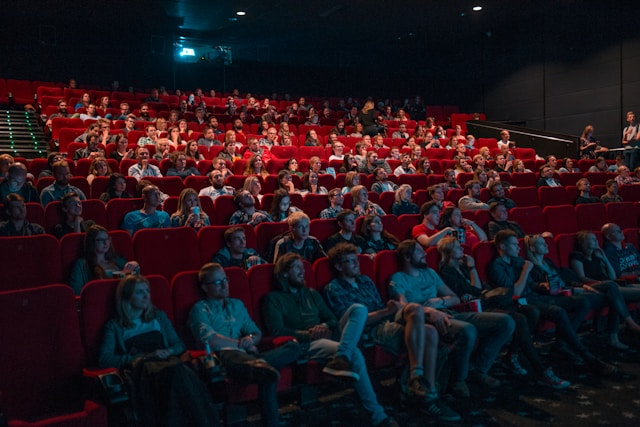Last night, as my friend suggested we head out to catch a movie, I realized it had been ages since I’d seen a new film debut in the cinema. In fact, it had been at least four months since I last stepped into a theater.
Curious, I did a bit of digging and found startling streaming vs. cinema statistics: only 14% of people now prefer watching movies at the cinema compared to using a streaming service. This revelation was quite concerning for me, prompting a deeper reflection on the state of the cinematic experience.
Is the age-old tradition of going to the movies on the brink of extinction? Are streaming platforms poised to take over, killing the billion-dollar industry completely?
Join me on this journey of discovery as I delve into the evolving landscape of film consumption. I’ll explore the competition of movie theaters vs streaming. Further expanding on whether or not streaming services are potentially killing off the cinema culture.
Streaming vs. Cinema Services – The Rise of New Era
This can be hard to believe for some people, but streaming services were not the go-to platform to enjoy movies. Let’s explore how these dominating services were initially introduced:
The Birth of Streaming Platforms
Streaming platforms first debuted in the early 2000s when companies like Netflix and Hulu began offering online streaming services. Over time, these platforms focused on providing a vast library of movies and TV shows for users to stream on their computers.
With advancements in technology and internet infrastructure, these streaming platforms gained popularity, leading to the decline of physical media, such as DVDs and Blu-rays.
The Slow and Steady Shift in Consumer Behavior
I must admit that the convenience and accessibility offered by streaming platforms have significantly influenced consumer behavior. Viewers are no longer bound by fixed schedules and limited choices dictated by traditional broadcast networks.
With a wide range of content available with some clicks, consumers can set the pace for their entertainment experiences. The concept of binge-watching entire seasons is the new hit, allowing viewers to discover the story in mere hours.
Challenging the Status Quo
Streaming platforms have also played a significant role in challenging societal norms and pushing boundaries in terms of content. With fewer restrictions and regulations compared to traditional broadcast networks.
They can explore controversial topics, portray complex characters, and tackle social issues head-on. Without this freedom, I am sure none of us could have streamed these amazing TV shows: Euphoria, Black Mirror, and The Handmaid’s Tale.
Allowing Global Accessibility
Streaming platforms have transcended geographical boundaries, allowing content to reach audiences worldwide. The globalization of entertainment has led to the discovery of international films, series, and documentaries that otherwise would have gone unnoticed.
If you check Reddit, you will see that users worldwide are now watching Hollywood movies and sharing their thoughts on acting, plot, and picturization. Moreover, affordable subscription plans have made it easier to follow new releases from home.
The Future of Streaming Platforms
Due to technological advancements like 5G connectivity, virtual reality, and augmented reality, streaming platforms have a very bright future. I believe this trend is another reason why the cinema is dying.
If viewers can experience 3D movies at home with a one-time investment, they are less likely to spend additional money to visit a theater every time a new film is released. This convenience of home viewing can significantly reduce the frequency of cinema visits.
Challenges and Concerns Faced by Streaming Platforms
While streaming platforms have brought about numerous benefits, they are not without challenges and concerns. One of the major concerns is the saturation of the market. Currently, 200+ streaming platforms are providing services worldwide.
With an increasing number of streaming services entering the scene, consumers can be overwhelmed by the sheer volume of options available. Subscription fatigue can set in, leading to a potential decline in subscriber numbers for individual platforms.
Additionally, the dominance of a few major streaming platforms can raise questions about monopolistic practices and the concentration of power. These platforms’ control over content distribution and their potential influence over creative decisions can impact the diversity and variety of content available.
The Enduring Appeal of Cinemas
Even though streaming platforms spread like a jungle fire, they cannot rival the cinematic experience. Last night, when I was watching Dune Part 2 in the theatre, I was having this thought constantly. Here is the list of reasons why I think Cinemas can never go out of style:
The Big Screen and Sound Systems
The fundamental appeal of cinemas for me lies in their immersive visual and auditory experience. Sitting before the vast expanse of the big screen I had an experience that even the largest home television cannot deliver.
Coupled with state-of-the-art sound systems like Dolby Atmos, which allows sound to move in three-dimensional space, cinemas create an environment that is not just seen and heard but truly felt.
The Communal Experience
One of the most significant aspects of watching a movie in a theater is the communal experience it offers. Unlike the isolation I often feel when streaming content at home, cinemas provide a venue for shared experiences with friends, family, and strangers. The collective reactions—laughter, gasps, and applause—enhance the overall fun of the movie.
Modern Day Cinema Challenges
Cinema chains are grappling with various economic challenges. The fixed costs of maintaining and operating theaters—rent, utilities, labor, and maintenance—are substantial. With declining ticket sales, these expenses become increasingly difficult to manage.
Additionally, the revenue split from ticket sales heavily favors distributors, especially for blockbuster films, which squeezes the margins for theater owners.
COVID-19 has also affected cinema houses, declining the overall yearly visits. Before the pandemic, there was a noticeable drop in attendance as consumers began to favor the convenience of streaming services. However, the pandemic brought about unprecedented disruptions, leading to a steep decline in box office revenues.
Digital Transformation To Lower Streaming Services Impact on Movie Theaters
When researching who is winning the battle of streaming platform vs cinema, I must say that cinema is not about to die anytime soon. Theatre owners are using digital transformation to improve the overall experience, attracting more customers by the day.
Rolando Rodriguez, chairman of the National Association of Theatre Owners, shared his statement:
Consumers are a lot more selective, and I think that for the economics that are necessary, you’re not going to see these 30-plexes anymore.
Rodriguez explained that most newly built locations will range between 12 and 16 screens, and those with larger, preexisting footprints will look to repurpose some space for supplementary activities for moviegoers, like arcades, bowling alleys, or bars.
As the space contracts, cinema operators are investing in the basics, improving sound, picture quality, and seating and bolstering their food and beverage offerings, events, and alternative programming. The aim is to improve moviegoers’ baseline experience regardless of the ticket type they purchase.
Larry Etter, senior vice president at family-owned regional chain Malco Theatres, also shared his perspective on this dilemma:
We do better when people get in the habit of seeing. And I think that’s what’s going to happen. I think we’re going to recreate the habitual effect that on Friday nights or Saturday nights or whatever it is, we’re gonna go to the movies.
The Premium Push
Already, the industry is seeing improvements in ticket sales. The 2023 box office tallied $958.5 million in ticket sales, up nearly 50% compared to last year and down just 25% from 2019. This is a marked improvement from the meager $98.7 million box office tally during the same period in 2021.
While cinema operators are pleased that studio production has increased, they no longer take audiences for granted. To that end, operators have started upgrading projectors.
Over the last few years, movie theater operators have removed traditional digital projectors and installed laser units, citing cost savings over time and better picture quality for moviegoers.
Etter further said:
It’s a little bit expensive, but it will produce a better product on the screen. The more light you have the clearer everything is and the easier it is to see. And it will be much more economical. It’s sustainable because you are going to use about 60% of the utilities that you did before.
Many theater operators are planning similar upgrades to sound systems, saying they have partnered with companies like Dolby to bring quality speakers into their auditoriums. Across the industry, theater chains big and small are also replacing outdated stadium seating with recliners in a bid to improve the overall cinema experience.
Final Thoughts on Streaming vs. Cinema
Streaming services provide convenient, cost-effective access to a vast range of content from home. Meanwhile, cinemas offer a unique sensory and social experience, with innovations in audio-visual technology and luxury seating.
However, cinemas struggle with declining attendance, accelerated by the pandemic and competition from home entertainment, while streaming platforms face market saturation and subscriber fatigue.
Will streaming kill movie theaters? I doubt it. The future likely involves a coexistence instead of the current battle of streaming vs. cinema, adapting to consumer preferences to stay relevant in the evolving entertainment landscape.




